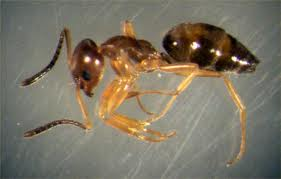Odorous house ants are small ants about 1/8th inch long and dark brown in color. They are found throughout the U.S. and in spite of their name, are only an occasional pest in the house. Their name comes from the disagreeable odor similar to the smell of rotten coconuts, that is given off when the worker ants are crushed.
Odorous house ants commonly nest outdoors in the soil under stones, logs, mulch, debris and other items. They will also nest indoors in wall and floor voids, particularly in moist or warm areas. If only a few workers (wingless ants) are observed in the house it is an indication that they are nesting outdoors and entering the house in search of food. If winged swarmers are found indoors, or if workers are consistently seen in great abundance, it likely indicates they are nesting within the house.
Odorous house ants regularly forage for food along well-traveled trails. They feed on dead insects, sweets and meats. One of their favorite foods is the sweet honeydew produced by plant sap feeding insects such as aphids and mealybugs.
Control of odorous house ants should begin with an attempt to locate the origin of the ants. Careful and frequent observation may be necessary to develop an opinion about the source. Ants entering from outdoors can be discouraged by sealing as many cracks and gaps in exterior walls as possible.
How to Get Rid of Odorous House Ants
•Good sanitation,Keep all food sources sealed.
•Repair leaky pipes and faucets.
•Eliminate standing water. Pests, such as ants, mosquitoes and termites, are attracted to moisture.
•Limit food preparation and consumption to one or two areas of the home that are cleaned daily.
•Eliminate gaps and cracks in the foundation, baseboards, window frames, and door frames with caulk or other appropriate material to eliminate ant entryways.
•Materials such as stacked or piled lumber, stones, bricks, leaf litter, heavy mulch, and other debris that serve as potential ant harborages should be removed as far from the structure as possible.
•Trim the branches of trees, shrubs, and other vegetation that may serve as ant highways so they do not touch the structure.
